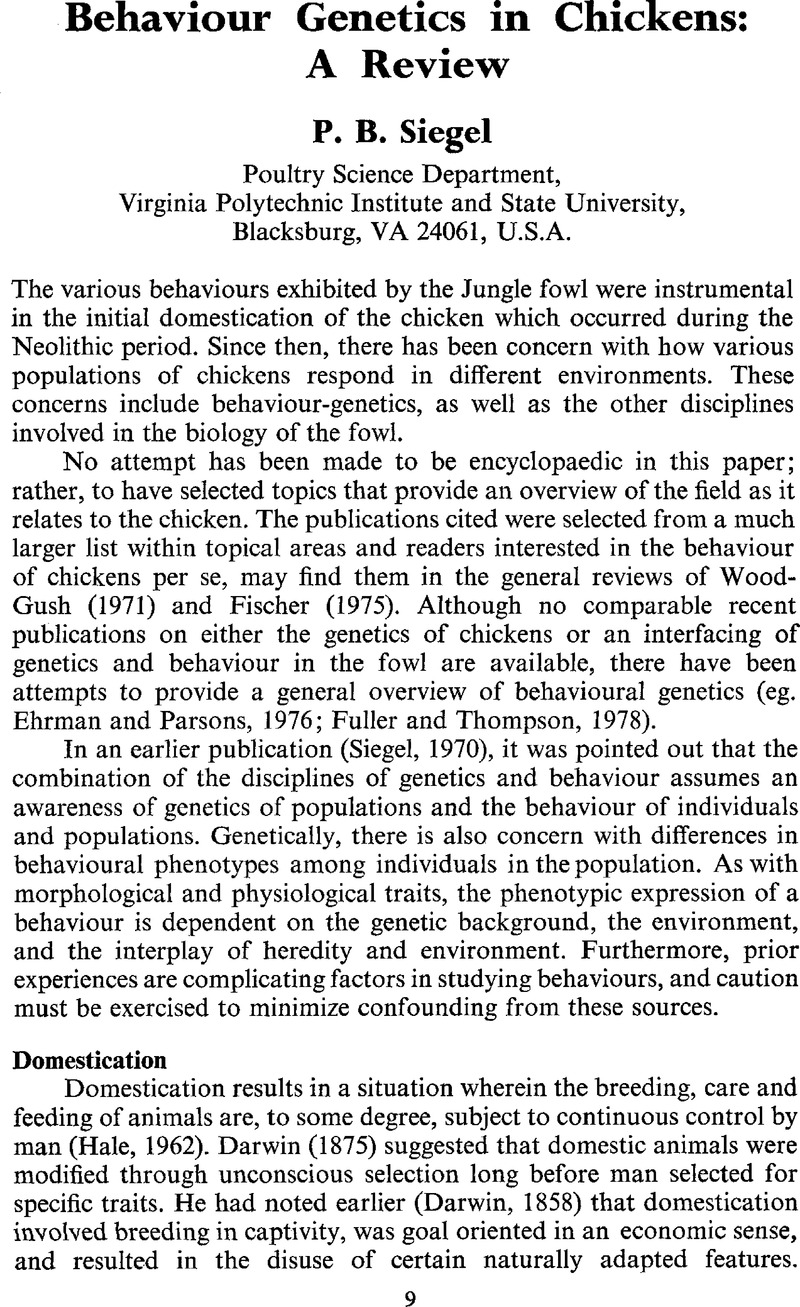Crossref Citations
This article has been cited by the following publications. This list is generated based on data provided by Crossref.
Faure, J. M.
1981.
Bidirectional selection for open-field activity in young chicks.
Behavior Genetics,
Vol. 11,
Issue. 2,
p.
135.
Provine, Robert R.
1983.
Chicken muscular dystrophy: An inherited disorder of flight.
Developmental Psychobiology,
Vol. 16,
Issue. 1,
p.
23.
Hill, J. A.
1983.
Indicators of Stress in Poultry.
World's Poultry Science Journal,
Vol. 39,
Issue. 1,
p.
24.
Siegel, P.B.
1984.
The role of behavior in poultry production: A review of research.
Applied Animal Ethology,
Vol. 11,
Issue. 4,
p.
299.
EHRICH, M.
BRILES, R.W.
BRILES, W.E.
DUNNINGTON, E.A.
MARTIN, A.
SIEGEL, P.B.
and
GROSS, W.B.
1986.
Neurotoxicity of Triorthotolyl Phosphate in Chickens of Different Genotypes in the Presence and Absence of Deoxycorticosterone.
Poultry Science,
Vol. 65,
Issue. 2,
p.
375.
Jones, R. Bryan
1986.
The tonic immobility reaction of the domestic fowl: a review.
World's Poultry Science Journal,
Vol. 42,
Issue. 1,
p.
82.
Kohane, M. J.
and
Parsons, P. A.
1988.
Evolutionary Biology.
p.
31.
Hartmann, Werner
1988.
From Mendel to multi‐national in poultry breeding1.
British Poultry Science,
Vol. 29,
Issue. 1,
p.
3.
Siegel, Paul B.
1989.
The genetic‐behaviour interface and well‐being of poultry1.
British Poultry Science,
Vol. 30,
Issue. 1,
p.
3.
Hartmann, Werner
1989.
From Mendel to multi-national in poultry breeding.
World's Poultry Science Journal,
Vol. 45,
Issue. 1,
p.
5.
WEBSTER, A.B.
and
HURNIK, J.F.
1991.
Behavior, Production, and Weil-Being of the Laying Hen..
Poultry Science,
Vol. 70,
Issue. 3,
p.
421.
Launay, F.
Mills, A.D.
and
Faure, J.M.
1993.
Effects of test age, line and sex on tonic immobility responses and social reinstatement behaviour in Japanese quail Coturnix japonica.
Behavioural Processes,
Vol. 29,
Issue. 1-2,
p.
1.
Provine, R. R.
1994.
Perception and Motor Control in Birds.
p.
135.
Zulkifli, I.
and
Siegel, P.B.
1995.
Is there a positive side to stress?.
World's Poultry Science Journal,
Vol. 51,
Issue. 1,
p.
63.
HESTER, PATRICIA Y.
MUIR, W.M.
CRAIG, J.V.
and
ALBRIGHT, J.L.
1996.
Group Selection for Adaptation to Multiple-Hen Cages: Hematology and Adrenal Function ,.
Poultry Science,
Vol. 75,
Issue. 11,
p.
1295.
Jones, R B
and
Hocking, P M
1999.
Genetic Selection for Poultry Behaviour: Big Bad Wolf or Friend in Need?.
Animal Welfare,
Vol. 8,
Issue. 4,
p.
343.
Jones, R.B
Marin, R.H
Satterlee, D.G
and
Cadd, G.G
2002.
Sociality in Japanese quail (Coturnix japonica) genetically selected for contrasting adrenocortical responsiveness.
Applied Animal Behaviour Science,
Vol. 75,
Issue. 4,
p.
337.
Satterlee, DG
Marin, RH
and
Jonest, RB
2002.
Selection of Japanese quail for reduced adrenocortical responsiveness accelerates puberty in males.
Poultry Science,
Vol. 81,
Issue. 7,
p.
1071.
Odeh, FM
Cadd, GG
and
Satterlee, DG
2003.
Genetic characterization of stress responsiveness in Japanese quail. 2. Analyses of maternal effects, additive sex linkage effects, heterosis, and heritability by diallel crosses.
Poultry Science,
Vol. 82,
Issue. 1,
p.
31.
Marin, Raul H
and
Satterlee, Daniel G
2003.
Selection for contrasting adrenocortical responsiveness in Japanese quail (Coturnix japonica) influences sexual behaviour in males.
Applied Animal Behaviour Science,
Vol. 83,
Issue. 3,
p.
187.



